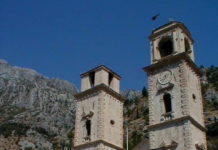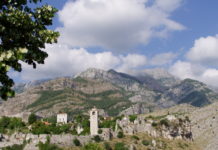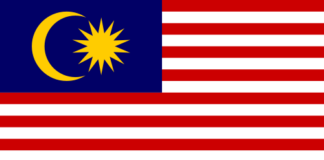Landesname
Der offizielle Name lautet Republika Crna Gora beziehungsweise dementsprechend Republik Montenegro auf Deutsch. Die Kurzform lautet Црна Гора (kyrillisches Alphabet) beziehungsweise Crna Gora mit lateinischen Buchstaben. Beide Wörter sind typisch Slawisch – “Crna” bedeutet “Schwarz” und “Gora” heisst in beinahe jeder slawischen Sprache “Berg”. Der Name ist ein alter, slawischer Name und bedeutet eigentlich nicht “Schwarze Berge” sondern “Voller Berge” (wer das Land kennt, weiss warum). Der Name tauchte zuerst im 13. Jahrhundert auf – davor war Montenegro weder ein Land noch eine Provinz.
Venetianer griffen den Namen auf und übersetzten ihn – daher der italienische (eigentlich venetische) Name Montenegro (= Schwarzer Berg), der heute auch im Englischen und Deutschen benutzt wird. In vielen anderen Sprachen (Türkisch, Isländisch, Kantonesisch zum Beispiel) wird der Name jedoch jeweils in die Landessprache übersetzt – auch die Nachbarn aus Albanien übersetzen den Namen und nennen das Land somit Mali i Zi.
Fläche & Bevölkerung
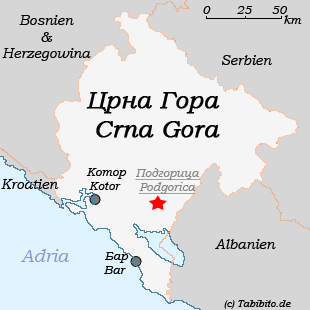
13,812 km² – damit ist Montenegro etwas kleiner als Schleswig-Holstein oder halb so groß wie Belgien.
Montenegro hat rund 680’000 Einwohner und ist damit eher spärlich besiedelt (Schleswig-Holstein hat rund 2,8 Millionen Einwohner). Hinzu kommt, dass die meisten Bewohner entlang der Küste oder in der Hauptstadtregion wohnen. Der Trend ist leicht positiv seit einigen Jahren.
Die Bevölkerung ist reichlich gemischt: Montenegriner machen 45% aus, Serben 29%, Bosniaken 9%, Albanier 5%. Hinzu kommen weitere Minderheiten wie Kroaten und Sinti und Roma.
Religion
Die Religionszugehörigkeit richtet sich stark nach der ethnischen Zugehörigkeit. Der Großteil (Montenegriner und Serben) sind Serbisch-Orthodoxen Glaubens, während viele Albaner und Bosniaken Muslims sind. Der Römisch-katholischer Glauben ist nur gering vertreten.
Zeitzone
Wie in Mitteleuropa. Auch mit Sommerzeit.
Sprache
Aufgrund der zahlreichen Ethnien gibt es auch zahlreiche offizielle Sprachen, wobei sich die meisten Sprachen (vom Albanischen abgesehen) recht stark ähneln. Montenegrinisch ist die erste Amtssprache, doch je nach Region zählen auch Serbisch, Kroatisch, Bosnisch und Albanisch zu den Amtssprachen. Bei einer Volkszählung 2003 gaben jedoch nur 22% an, Montenegrinisch als Muttersprache zu sprechen. 62% bezeichneten Serbisch als ihre Muttersprache.
In jüngerer Zeit gab und gibt es Diskussionen darüber, wie stark sich Montenegrinisch eigentlich vom Serbischen unterscheidet: Ist Montenegrinisch eine eigene Sprache oder ein serbischer Dialekt? Die Diskussion darüber würde den Rahmen dieser Seite sprengen, aber es geht dabei vor allem um den proto-slawischen Laut Ѣ (ě) – “Jat” (kein eigener Buchstabe im montenegrinischen Alphabet, wohlgemerkt): Es geht darum, wie zum Beispiel das Wort für “weiß” ausgesprochen wird: Im Serbischen ist es “beli”, im Montenegrinischen, Bosnischen, Slowenischen usw. ist es eher ein “bijeli”.
Die Diskussion um die Landessprache ist jedoch stark politisch beeinflusst. Nationalistische Kreise lehnen Serbisch als Landessprache ab und betonen, dass Montenegro seine eigene, selbständige Sprache hat. Allgemein kann jedoch gesagt werden, dass Montenegriner, Bosnier, Serben, Kroaten usw. recht problemlos miteinander kommunizieren können. Auch mit Russisch kommt man entsprechend relativ gut voran, wobei die Unterschiede in diesem Fall jedoch bereits beträchtlich sind und Gespräche in der Konstellation eher holprig werden. Vor allem im südlichen Montenegro ist Albanisch weit verbreitet. Dabei gilt zu beachten, dass Albanisch eine Ausnahme in der Region ist und mit slawischen Sprachen herzlich wenig gemein hat.
Wie auch in Serbien werden in Montenegro zwei Alphabete benutzt: Das lateinische und Asbuka, das kyrillische. Das lateinische Alphabet hat ein paar diakritische Zeichen aufzuweisen – als da wären Č, Ć, Dž, Đ, Lj, Nj, Š, Ś, Ž und Ź. Im kyrillischen gibt es Buchstaben wie Ђ, З́. Ј, Љ, Њ, С́, Ћ und Џ, die es im Russischen zum Beispiel nicht gibt..
Allgemeines
Vorwort
So far, I’ve only been to Montenegro twice – once in 2001, then coming from Kroatien, in the aftermath of the war. At that time, no ordinary person was allowed to enter Serbien, but my wife and I managed to get into Montenegro. The second time was in 2005 – coming from Albanien and leaving for Serbien. Montenegro finally declared independence in 2006. This means I haven’t visited Montenegro after it became independent – but as far as I heard, things haven’t changed that much. However, things might change, so the following information might be out of date.
Visa
Almost all European nationalities, as well as US citizens, Canadians, Australians, New Zealander, Japanese etc. can stay up to 30 days without visa. As with all other countries, the passport should be valid for at least another 6 months.
Geld
Already during the war in the 1990ies, Montenegro unilaterally adopted the Deutschmark as its currency, although it was still united with Serbien which had its own currency. After the introduction of the Euro, Montenegro – again unilaterally – adopted the Euro as its currency.
There are ATM’s accepting all major credit cards as well as Cirrus and Maestro cash cards – however, these ATM’s are rather hard to find outside the capital and the coastal area. Some banks and hotels can exchange money.
Costs
Montenegro is a comparetively cheap destination – cheaper then Kroatien for example. It’s no big problem to find decent accommodation even in summer and along the popular coast for around € 10 per night. A good dinner in restaurants rarely costs more then € 10, but it’s also possible to get stuffed for as less as € 2. However, especially in summer and in towns popular with visitors, restaurants can be more expensive. Travelers on a small budget should be careful when ordering fish dishes – prices are often for 100 g, so it can get really expensive if it’s a large fish… Since Montenegro is not very large, bus and train rides aren’t expensive either.
Anreise
By bus, train, plane or boat. There are some direct flights from Germany, Austria and a few other countries to Montenegro – namely the airports of Podgorica and Tivat – with the latter being much closer to the coast. There are several charter flights from European cities in summer. Regular flights however aren’t very frequent. The national carrier is called Montenegro Airlines.
Regular ferries cross the Adriatic Sea from Bari and Ancona in Italy to Bar. They run over night, take 10 hours and 16 hrs respectively. Ticket prices for the Bari-Bar ferry start at € 51 – including the € 7 port tax. There are also ferries running along the coast to Durrës near Tirana in Albanien – prices start at € 40.
There are long-distance busses from Germany, Austria, Switzerland and many towns in Ex-Yugoslavia as well as Albanien. A daily bus runs from Dubrovnik to Kotor – in 2001, the price was 71.5 Kuna (around € 9) then, the trip took almost 3 hours. Microbuses run from Shkoder (North Albanien) to Ulcinj in Southern Montenegro and to Podgorica, the capital. Buses start in Shkoder at 3 pm and 5 pm, the ticket costs € 5. There are also buses to Bosnien and Serbien.
There are no train connections to Kroatien and Albanien (actually there is one to the latter, but that’s for freight only). Montenegro only has 249 km of railroads – most of it taken by the international train connection from Bar to Serbien. There are two daily trains from Bar to Belgrade and two more passing Belgrade, running via Novi Sad to Subotica in Northern Serbien. All of those trains also stop in Podgorica (around 1 hour). The whole way to Belgrade takes around 8½ hours. Note that those trains are often completely booked out in summer. In that case, you may need to resort to a 1st class ticket, which costs € 21.20 (as of 2005).
Border crossings
There were two border crossings to Albanien: The larger one is called Han i Hotit between Shkodër and Podgorica North of Lake Scutari, the smaller is at Muriqan between Shkodër and Ulcinj.
There’s only one crossing to Kroatien – at Debeli brijeg near the coast. The closest town on the Montenegrin side is Igalo. The next large town in Kroatien is Dubrovnik.
Border crossings to Bosnien and Hercegovina are in Sitnica, Vilusi, Vracenovici, Scepan polje and Metaljka.
Additionally, there are numerous border crossings to Serbien.
Food and drinks
The typical Balkan diet (grilled meat en masse, meat pies etc) plus some extras. Montenegro has it’s share of the Adriatic Sea and some large lakes, so there is fresh fish as well. Balkan food means that goats and sheeps play an important role – making mutton, lamb, goat as well as goat’s and sheep’s cheese part of the staple diet. To cut it short – Montenegrin food is mostly very fresh, healthy and plentiful.
Montenegro’s #1 beer is called Nikšic and it’s not too bad. Montenegro has plenty of mountains, a lot of limestone and many sunny days – a perfect location for growing wine. Montenegrin red and white wine are definitely worth a try – there is a lot of local, excellent wine that isn’t sold abroad.
Montenegro’s Topographie, Natur und Klima
Montenegro ist ein verhältnismäßig kleines Land, doch das bedeutet nicht, dass es Vielfalt in Sachen Natur mangelt. Der Landesname “voller Berge” deutet bereits an, dass nahezu das ganze Land bergig ist – es gibt nicht einmal größere Ebenen entlang der Küste. Einzig die Gegend um die Hauptstadt Podgorica sowie der äußerste Süden ist relativ eben.
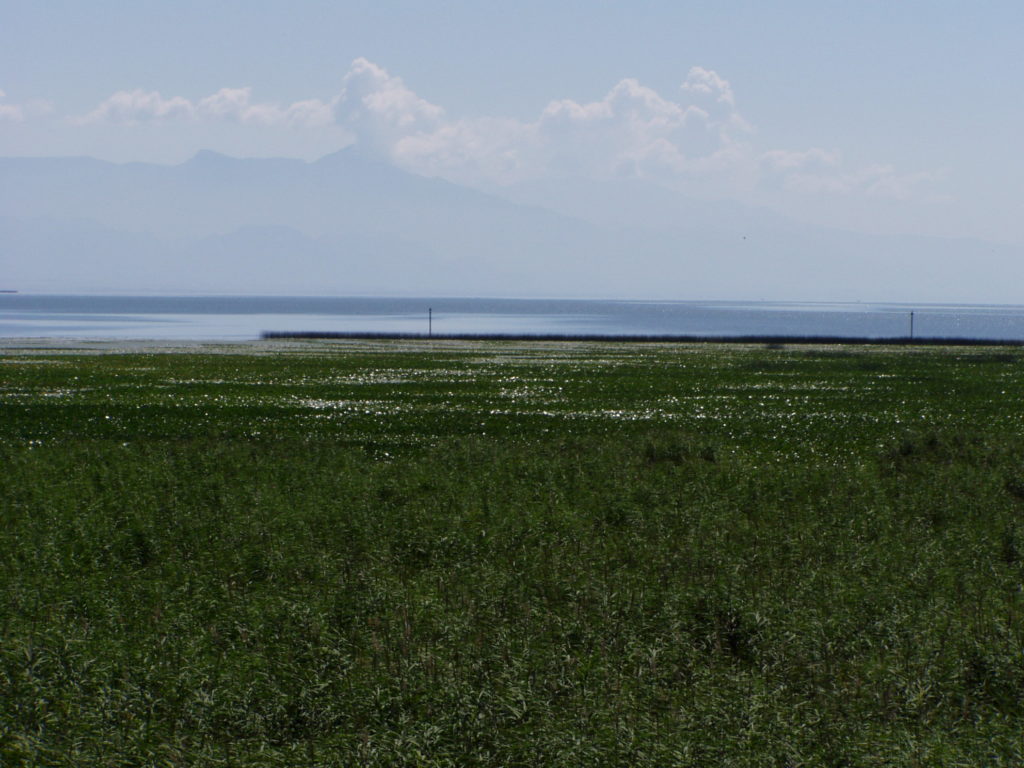
Die Berge beginnen direkt an der Adriaküste, und Kalkstein dominiert die Region. Das bedeutet, dass es vielfältige Karsterscheinungen gibt. Die Berge in der Küstenregion sind dabei bis zu 2’000 m hoch. Im Norden und Osten schliessen sich die Bergketten Durmitor sowie die schroffen Prokletije-Berge (auch “Albanische Alpen genannt) an. Der höchste Berg des Landes ist der 2’536 Meter hohe Zla Kolata in den Prokletije-Bergen.
Besonders beeindruckend sind die Orjen-Berge nahe der Küste. Diese bilden das höchste Bergmassiv innerhalb der Äußeren Dinariden. In dieser stark verkarsteten Landschaft befindet sich unter anderem die Boka Kotorska (Bucht von Kotor) (siehe Kotor) – ihres Zeichens der größte Fjord in Südeuropa mit bis zu 1’300 Meter hohen Felsformationen direkt an der Küste.
Die Tara-Schlucht nahe der bosnischen Grenze ist an der tiefsten Stelle rund 1’300 Meter tief. Das gesamte Tal ist 78 km lang, und damit ist die Tara-Schlucht der längste und tiefste Canyon Europas. Am Fluss Tara beginnt auch der Nationalpark Biogradska gora (Biograder Berge) – einer von vier Nationalparks im gesamten Land. Die anderen drei befinden sich im Durmitor-Massiv, dem Skutarisee (auch: Shkodrasee, der größte See auf dem Balkan, siehe Bar: Skutarisee sowie die Lov?en-Berge.
Das Klima in Montenegro ist dreigeteilt – an der Küste ist es ausgeprägt mediterran, mit langen und warmen Sommern und milden Wintern. Die Durchschnittstemperatur im Sommer entlang der Küste beträgt 27 Grad, wobei das Wasser ebenfalls diese Temperatur erreichen kann. Die Küste wartet zudem mit 180 Sonnentagen auf – die meisten davon entfallen auf den Sommer. Mit anderen Worten – es regnet nicht oft im Sommer. Im Landesinneren ändert sich das Klima merklich – dort ist es wesentlich kühler und niederschlagsreicher. Der Zuba?ki kabao, ein Berggipfel in den Orjen-Bergen, gilt als feuchtester Ort Europas mit einer Niederschlagsmenge von 6’250 mm pro Jahr – das ist in etwa die 10-fache Menge dessen, was alljährlich in Berlin vom Himmel fällt. Dieser 1’894 m hohe Gipfel ist dabei 140 Tage im Jahr schneebedeckt.
Randnotiz: Die 260 km lange Küste Montenegros ist tektonisch reichlich aktiv. Zuletzt zerstörte 1979 ein verheerendes Erdbeben in der Region zahlreiche Orte entlang der Adriaküste.
Geschichte – kurzer Überblick
Montenegro’s geschichte is mainly dominated by the fact, that the interior of the country is very rugged, making it difficult to built settlements and the appropriate infrastructure. Additionally, large areas are characterized by karst phenomena, which means that the underground is not capable of keeping much water near the surface – as soon as the rain falls, the water is gone. This means that the geschichte of Montenegro is basically the geschichte of the Montenegrin coast only.
In early times, Montenegro very much shared the Geschichte of Kroatien or at least of the Dalmatian coast: Conquered by the Romans, becoming part of the Illyrian province of the West Roman empire, later hit by massive migration waves and finally conquered by the huge Ottoman empire but later on also by the Slavs. After the collapse of the Serbienn empire in the 13th century, the Principality of Zeta was founded on now Montenegrin soil. Zeta was never completely conquered by the Ottoman Empire – the latter as only interested in controlling the coast and two valleys.
Since 1528, orthodox bishops ruled the country, so Montenegro became something like a clerical state, although it was rather a loose union of several tribes and groups then an organized country. And it didn’t include the coastal area – at that time important towns such as Kotor or Bar were controlled by the Ottomans and later by the Venetians. Later on, parts of the coast fell to the Austrian monarchy – with Kotor for example remaining in Austrian hand until the defeat in 1918.
During the 19th century, Montenegro’s rulers decided to form strong ties with Tsarist Russia. Thanks to that policy, Montenegro could declare its independence from the Ottoman empire after the Russish-Turkish war in 1878. As a result of the Congress of Berlin, Montenegro won the territory around Bar, giving it access to the Adriatic Sea for the first time.
Within the next decades, Montenegro managed to gain more territory from the Ottoman empire, so the size of the country almost doubled until World War I. At that time, Montenegro was a monarchy with strong ties to its stronger neighbour Serbien and stuck between two super powers – Austria-Ungarn in the north and the Ottoman empire in the south. Montenegro got under pressure – and tried to free itself from the pressure by attacking the vast Ottoman empire. Montenegro therefore conquered Shkoder and the area around it, but they had to leave the present-day Albanienn territory soon. Technically one of the winners of the World War I, Montenegro didn’t really win – in 1918 they became one of many provinces of the newly created South Slavic kingdom, aka Yugoslavia. This also marked the end of the Montenegrin monarchy – the king died in exile in 1921.
For more information on the time between 1918 and 1992, see Geschichte of Serbien. While Kroatien, Slowenien and later Bosnien and Mazedonien separated from Yugoslavia, Montenegro remained in what was left of Tito’s Yugoslavia. This meant that Montenegro was hit hard by the war in the 1990ies as well – no fightings took place on Montenegrin soils, but together with Serbien the small country became isolated and suffered the embargo (and the fact that visitors stopped visiting). The war with Kroatien didn’t help the situation: The Yugoslav army partially advanced from Montenegro – when I talked to some Kroatienns in and around Dubrovnik, I sometimes was told “Those Montenegrins are as bad as the Serbs”.
Montenegro still formed a union with Serbien, when the conflict in the Kosovo developed into a full-scale war. Montenegro tried to stay neutral, and so it didn’t suffer heavy air strikes as much as Serbien. Around 2002, Montenegro showed interest in dividing from Serbien – but the EU and other countries were not too excited about it. Montenegro remained – with a high level of autonomy – with Serbien. Montenegro was asked to stay at least for four years with Serbien. And so, it tried again to separate on 21 May 2006. The result of the Montenegrin independence referendum was very tight (which is no surprise when looking at Montenegros ethnic groups: Serbienns are almost a majority). The turnout was higher then 85%. According to Serbien and Montenegrin law, 55% were necessary for the winner. Eventually, 55.5% of Montenegrins voted for independence – the southwest almost entirely pro-independence, almost the entire northeast (near Serbien) contra.
And so, as of 2008, Montenegro is the newest independent country in the world. Since it was Montenegro that opted for the split, all memberships etc. fell to Serbien, which means that Montenegro had to apply for membership in the UN and hundreds of other councils first. Happily, the separation was peaceful and acknowledged by everyone. It will be interesting to see, how Montenegro will develop in future – but this future will never be entirely without Serbien – ties between Montenegro and Serbien are simply too strong.
Further reading: Interesting Links
- www.visit-montenegro.org/: Website of the National Tourism Organisation of Montenegro with plenty of useful information. Comes in Italian, German and English.
- Private Seite über eine Montenegro-Reise – hauptsächlich über die Stadt Bar Photos
- www.montenegrolines.cg.yu: Montenegro Lines runs the ferries between Montenegro, Italy and Albanien. Their website comes in Montenegrin, Italian and English and includes timetables, ticket fares and more useful information.


